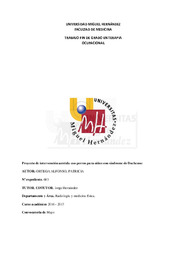Por favor, use este identificador para citar o enlazar este ítem:
https://hdl.handle.net/11000/26315Registro completo de metadatos
| Campo DC | Valor | Lengua/Idioma |
|---|---|---|
| dc.contributor.advisor | Hernández Mas, Jorge | - |
| dc.contributor.author | Ortega Alfonso, Patricia | - |
| dc.contributor.other | Departamentos de la UMH::Patología y Cirugía | es_ES |
| dc.date.accessioned | 2022-03-23T08:51:07Z | - |
| dc.date.available | 2022-03-23T08:51:07Z | - |
| dc.date.created | 2017-05-09 | - |
| dc.identifier.uri | http://hdl.handle.net/11000/26315 | - |
| dc.description.abstract | Hace muchos años ya se usaba a los animales como coterapeuta, pero no se era consciente de ello. En 1792, fue cuando se utilizó por primera vez a los animales en terapia, sucedió en Inglaterra. El síndrome de Duchenne, es la distrofia muscular más común diagnosticada durante la infancia. Limita significativamente los años de vida de los afectados. Es un desorden progresivo del músculo que causa la pérdida de su función. Debido a la rápida y progresiva evolución que conlleva la distrofia muscular, y conociendo que este tipo de terapias alternativas ha tenido beneficios en otros colectivos, creo que es necesario, trazar una línea donde se una a estos niños, antes de una mayor afectación, con esta forma de intervención. En España no hay ninguna asociación o entidad, que se dedique a la terapia asistida con perros en niños con distrofia muscular de Duchenne, y ese también es uno de los motivos por los que realizar este plan de intervención. Este proyecto, se llevará a cabo en las instalaciones de la asociación de enfermedades neuromusculares de la Comunidad Valenciana. Para llevar a cabo las sesiones, lo primero es formar el grupo, que tendrá 6 participantes, y además, establecer unos criterios para que sea lo más homogéneo posible. El objetivo general es diseñar un proyecto de intervención asistido con perros para niños con distrofia muscular de Duchenne; todas las actividades están destinadas a estimular las diferentes áreas de la persona, física, psíquica, sensorial y socia | es_ES |
| dc.description.abstract | Many years ago we used animals as co-therapist, but we weren’t aware of it. In 1792, it was when we used the animals in therapy for the first time. It happened in England. The Duchenne’s syndrome is the most common muscular dystrophy diagnosed during the childhood. This disease complicate the years of life of those affected. Is a progressive muscle disorder that causes lost of function. Due to the fast and progressive evolution of the muscular dystrophy, and knowing that this type of alternatives therapy’s has had benefits in others collectives, I believe that is necessary to draw a line where to connect this children, before they are more affected, whit this form of intervention. In Spain there aren’t any association or entity, who is dedicated to assisted therapy with dogs in children whit muscular dystrophy of Duchenne, and this also is one of the reasons to realise this plan of intervention. This project, it will be carried out in the facilities of the association of neuromuscular diseases of the “Comunidad Valenciana”. To realise the sessions, the first is the formation of group, that will have six participants, and almost, establish criteria to be as homogeneous as possible. The general objective is design a project of assisted intervention with dogs for children with muscular dystrophy of Duchenne. All activities are designed to stimulate the different areas of person: physical, psychic, social and sensory | es_ES |
| dc.format | application/pdf | es_ES |
| dc.format.extent | 34 | es_ES |
| dc.language.iso | spa | es_ES |
| dc.publisher | Universidad Miguel Hernández | es_ES |
| dc.rights | info:eu-repo/semantics/openAccess | es_ES |
| dc.rights | Attribution-NonCommercial-NoDerivatives 4.0 Internacional | * |
| dc.rights.uri | http://creativecommons.org/licenses/by-nc-nd/4.0/ | * |
| dc.subject | terapia ocupacional | es_ES |
| dc.subject | niños | es_ES |
| dc.subject | terapia asistida con animales | es_ES |
| dc.subject | distrofia muscular de Duchenne | es_ES |
| dc.subject.other | CDU::6 - Ciencias aplicadas | es_ES |
| dc.title | Proyecto de intervención asistida con perros para niños con síndrome de Duchenne | es_ES |
| dc.type | info:eu-repo/semantics/bachelorThesis | es_ES |

Ver/Abrir:
TFG patricia[568].pdf
1,74 MB
Adobe PDF
Compartir:
 La licencia se describe como: Atribución-NonComercial-NoDerivada 4.0 Internacional.
La licencia se describe como: Atribución-NonComercial-NoDerivada 4.0 Internacional.
.png)